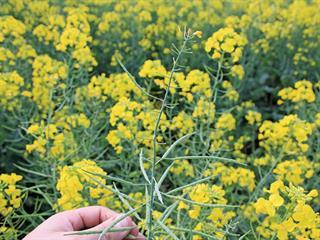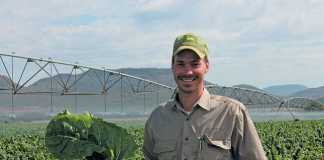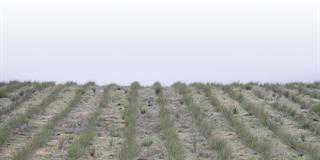
Will 2015 see a decline in canola plantings, following production problems last season? The question is currently being debated, but the answer will be known only in a month or two. At the time of writing this article in mid- April, canola plantings had commenced in the Swellendam area of the Western Cape, following early winter rainfall. To the west, however, farmers still awaited the start of the rainy season. Depending on rainfall, canola plantings could occur as late as June.
Meanwhile, seed seemed to be more readily available at an earlier stage, and five new cultivars have been released.
Despite the production problems experienced during the 2014 season, a total record crop of 122 000t was harvested. This was thanks to a year-on-year increase of roughly 31% in plantings. An area of more than 92 000ha was planted to canola and almost three-quarters of the harvest – 74% – came from the area between Caledon and Mossel Bay
in the Southern Cape.
The remainder was from the Western Cape’s Swartland area. This is according to Franco le Roux, agricultural resource manager at Southern Oil (Soill) in Swellendam. After three relatively cool production years which saw outstanding yields of between 1,4t/ ha and 1,8t/ha, the 2014 canola crop proved to be a very average 1,31t/ha. This was as a result of much warmer weather conditions during the flowering stage, which negatively affected pod development. When in bloom, canola plants tend to wean themselves if high temperatures and drought stress occur.
2015 canola projections
The graph on the opposite page shows areas planted to canola and crop yields from 1992 to 2014, as well as projections for 2015, which are dependent on normal weather patterns. Although Le Roux expects that the total 2015 plantings might decrease by 11,6% to 82 000ha, he says that the total crop size could be the same as last year’s – provided weather patterns are suitable.
“This is my gut feel. Apart from the weather, which should play along, my projections are based on the fact that farmers have access to more knowledge about canola cultivars and technical production practices. They also have better harvesting equipment, such as self-propelled swathers or windrowers,” he says.
Chairperson of the Protein Research Foundation (PRF) and the Canola Work Group, Gerhard Scholtemeijer, has a more bullish outlook. “We experienced a bit of a hiccup last year, but it wasn’t a huge blow,” he explains. “Until now we had no clear indication that there will be a sharp decline in canola plantings this year.
”In fact, agricultural co-ops expect the 2015 plantings to be very close to the total area planted last year,” he says, adding that weather patterns during winter will be the determining factor. More and more international companies were taking note of South Africa’s canola industry and were currently talking to the PRF, says Scholtemeijer. He adds that the PRF’s goal is to encourage canola plantings so that these reached 150 000ha within the next five years.
“Farmers are realising that canola is a cash crop in its own right, although canola production requires a bit more time and commitment than wheat and maize.”
Management practices
According to Le Roux, canola producers must pay attention to the following factors, as they are usually a producer’s biggest challenges:
Disease and weed management
Choose the right portfolio of cultivars for a specific area, substitute cultivars from year to year and apply optimum crop rotation for better disease and weed control.
Do not limit weed control to problematic lands, but carry it out on all canola lands. Every year, choose new cultivars that contain genes resistant to blackleg. This is especially important in the case of short rotations, such as when planting canola within a period of three years on the same land. The larger the planting, the more blackleg spores there will be in the air.
To achieve a yield of 1,5t/ ha or more, apply fertiliser correctly and spray against fungal diseases such as blackleg wherever necessary, and on time. Controlling blackleg can be expensive, but it is especially important for cultivars with a weak resistance against this disease, as well as on lands with a history of blackleg. The best way to control blackleg is to plant canola only every fourth year on the same land. Carry out foliar feedings on time.
Choose a mixture
of short and long growers. This will lengthen the period in which land can be swathed to two weeks.
Snail management
If conservation agriculture and minimum tillage are being used, it is important to control snails. This should be followed up proactively before the snails damage the canola lands. Snails should also be monitored in canola lands when wheat and barley are planted.
Sclerotinia management
Monitor this fungus regularly to determine if spraying is necessary. Crop rotation can also play a big preventative role in managing it.
Seed depth and number per hectare
Make it your goal to obtain a well-established stand of between 40 plants/m2 and 60 plants/m². Plant about 3kg seed/ha; the exact figure will depend on the thousand-kernel mass of every cultivar. Do not plant the seeds deeper than 1cm to 2,5cm. Due to its small size, only 15kg/ ha to 20kg/ ha nitrogen (N) should be placed alongside the seed when planting in order to prevent burning. The rest of the N should be placed deeper.
Limiting yield losses
Swathe the plants to limit yield losses due to pod shatter or wind damage. Swathing should be carried
out when 60% of the seed is coloured.
New cultivars
Five new imported canola cultivars will be available for the 2015 season to add to the 12 cultivars currently available in South Africa. This follows trials conducted in the Swartland and Southern Cape, according to Piet Lombard from the Directorate: Plant Sciences at the Western Cape’s Department of Agriculture.
(See table below)

Click on the table above to enlarge
Mitigating risk
Le Roux maintains that canola deserves its rightful place in the portfolio of cash crops on farms in the Swartland and Southern Cape. This, he says, is necessary to spread risk, and due to the advantages it offers in a crop rotation system. Canola is an oil seed crop, and thus spreads a small grain producer’s risks even more – the prices of oil seed and small grains are not dependent on each other.
Dirk van Papendorp, from the Tweekop farming enterprise between Swellendam and Heidelberg, agrees. Van Papendorp, who started planting canola in 1993, sows small grains and canola on a combined area of 1 700ha. Due to Tweekop’s planning for 2015, which is based on projected farming income per hectare and managing its cash flow, a decision was taken to downscale its canola plantings from last year’s 600ha to 450ha. Relatively good barley prices and yields also played a role in this decision.
Van Papendorp plants canola every second year on the same lands, and admits that his 2014 yield has been down to an average of 1,1t/ha, in contrast with the normal average of between 1,5t/ha and 1,6t/ha. He adds that he should increase his crop rotations to longer periods.
Although he is positive about the role that canola plays on crop farms in the Western Cape’s winter rainfall areas, he says he is looking forward to cultivars that offer more consistent yield. According to him, it is still a problem that South Africa does not have any canola cultivars of its own, and that all cultivars are imported.
Phone Franco le Roux on 028 514 3441 or email [email protected]. Phone Piet Lombard on 021 808 5415 or email [email protected].













